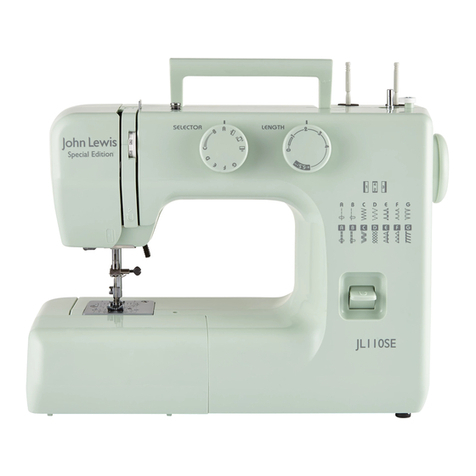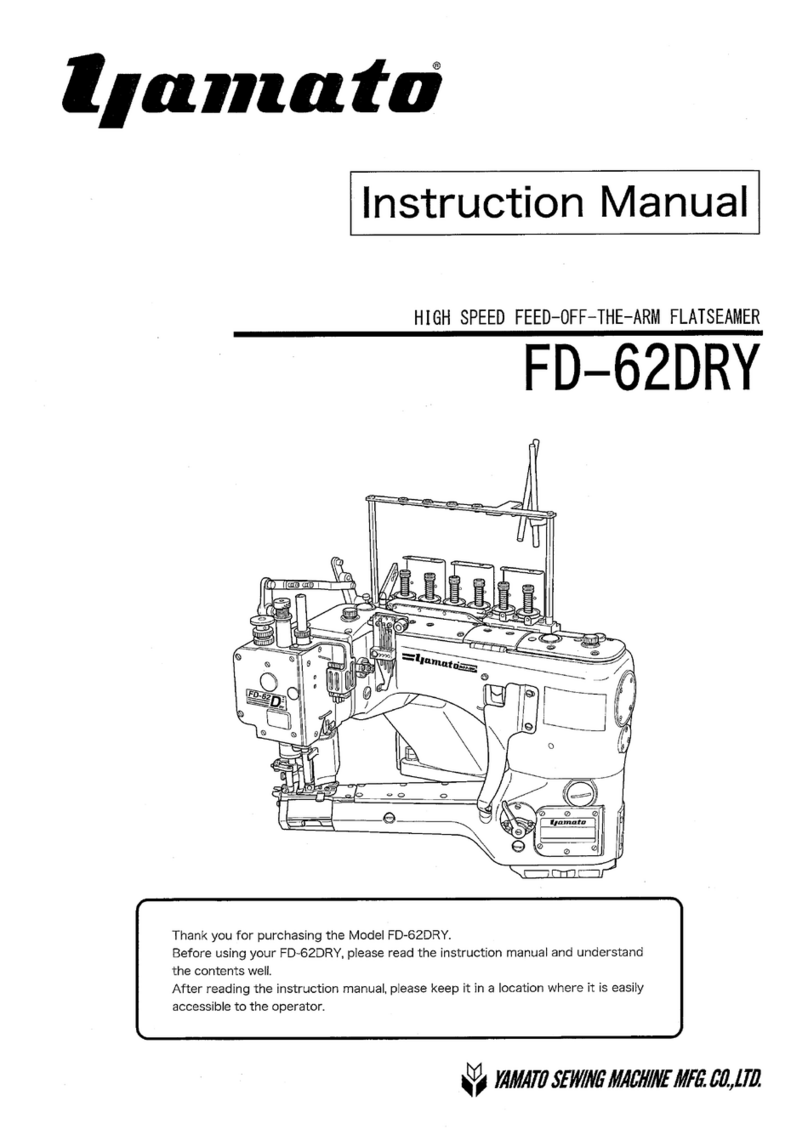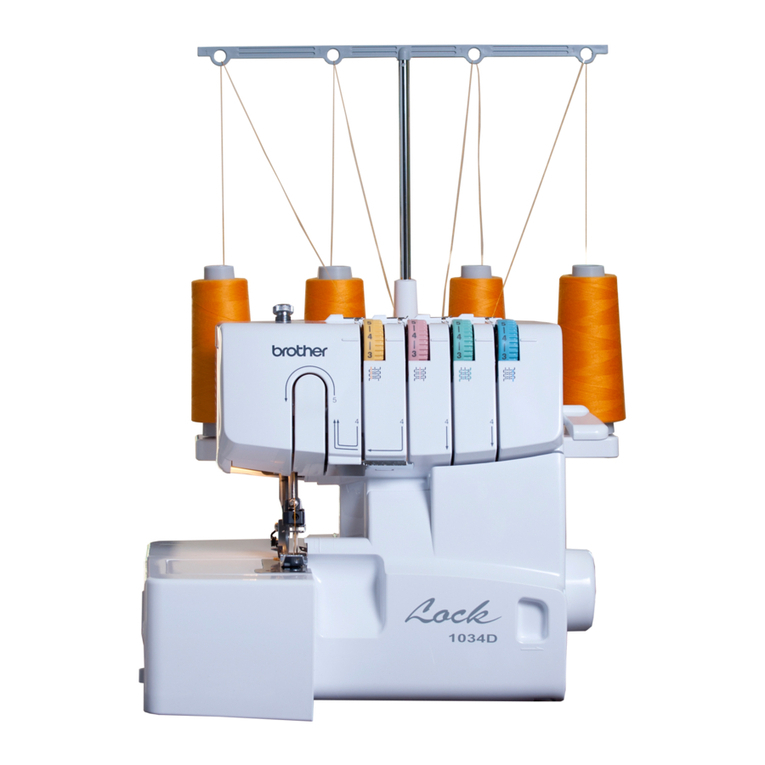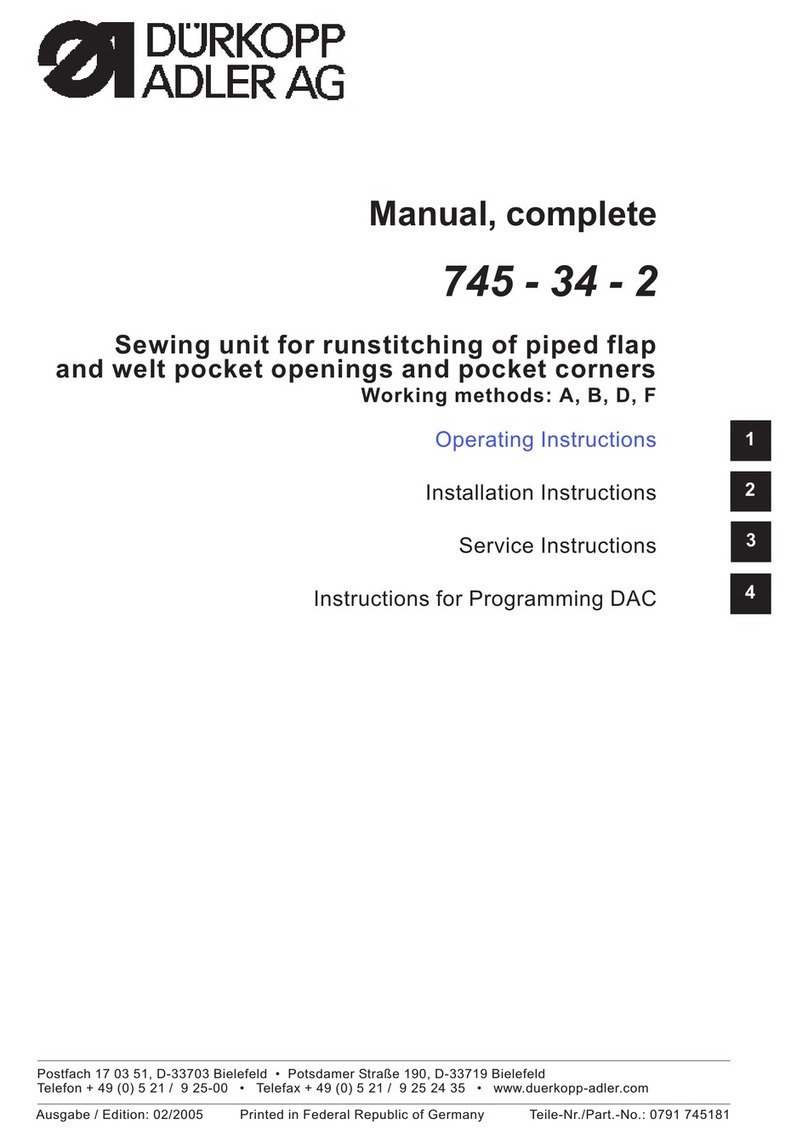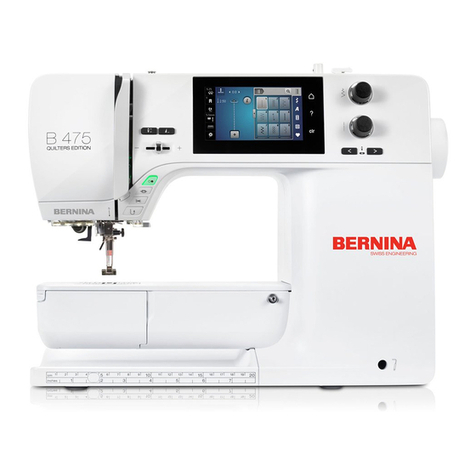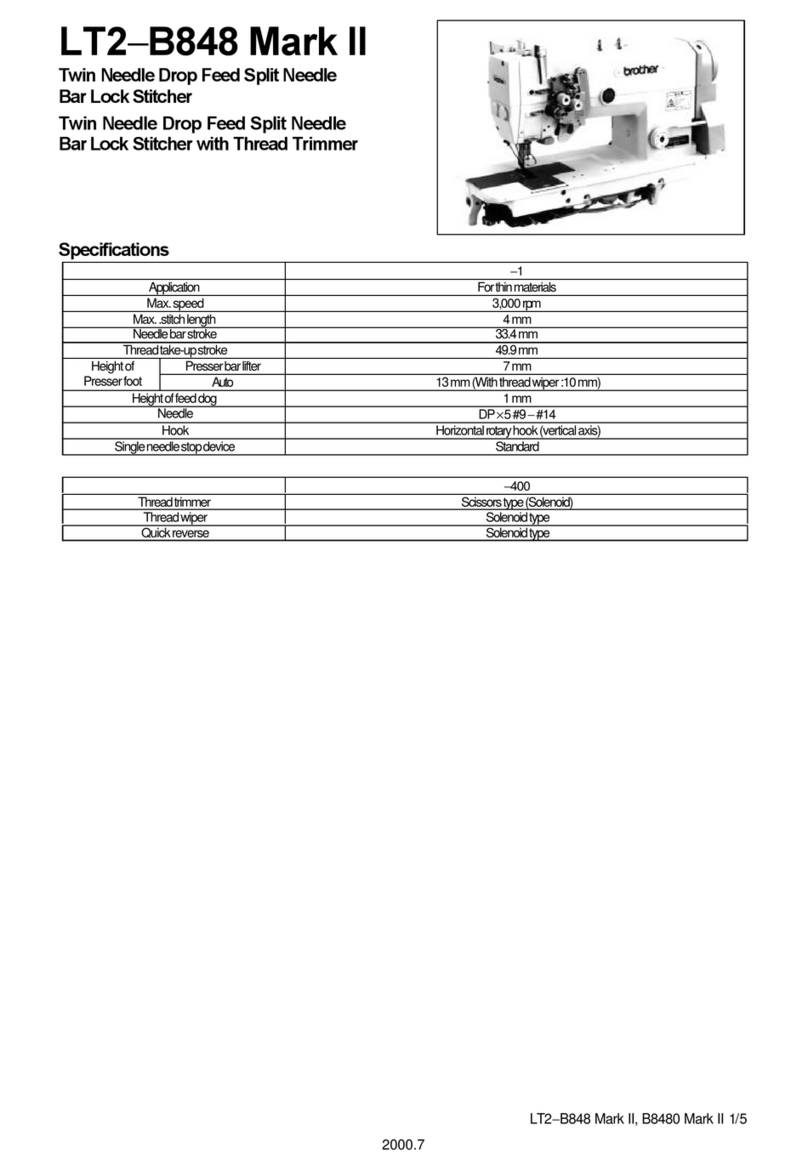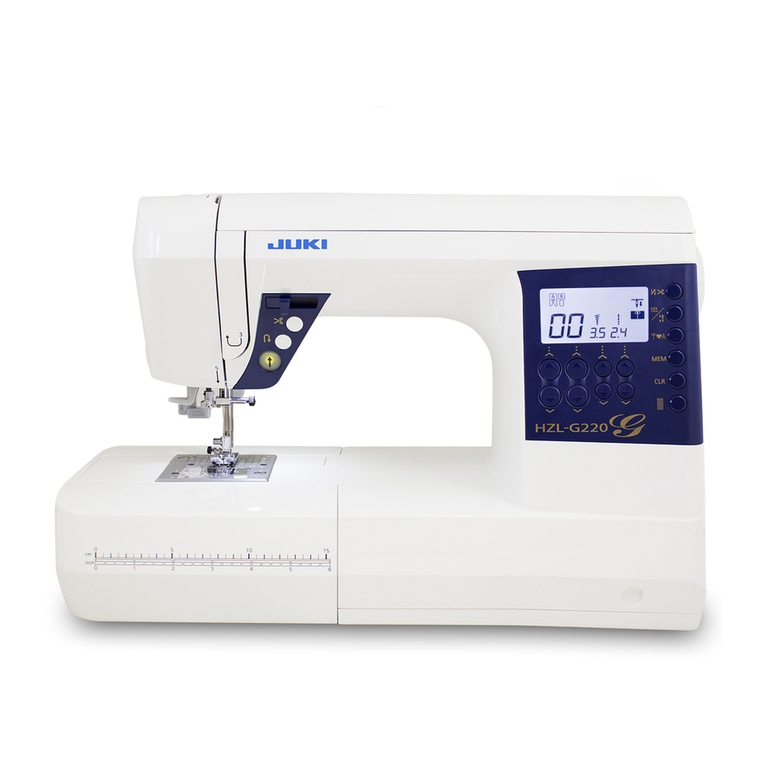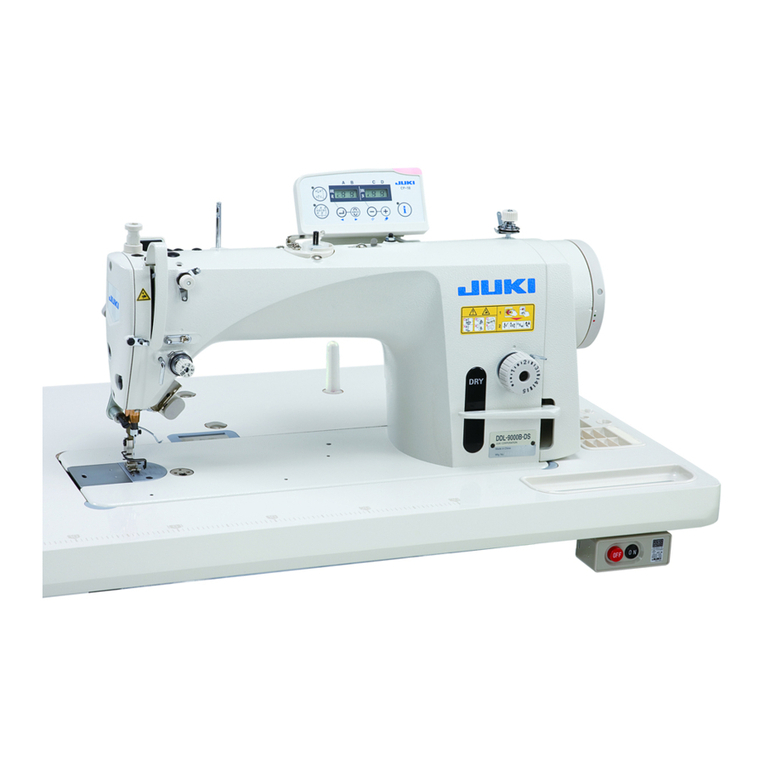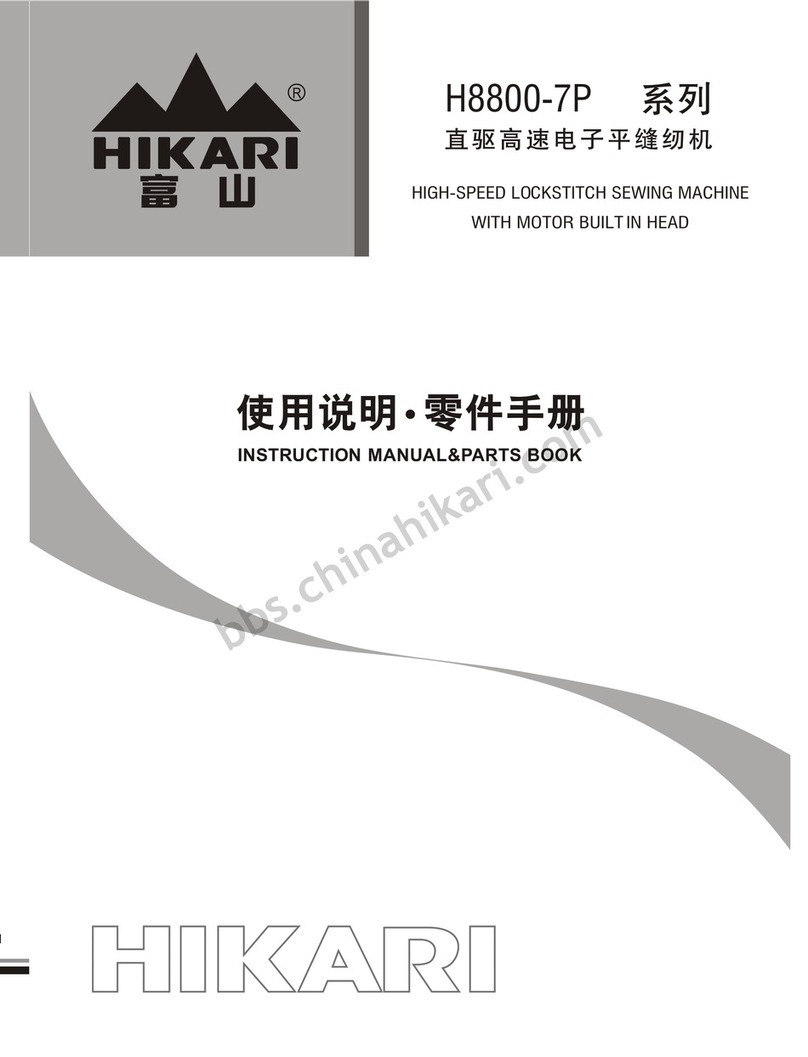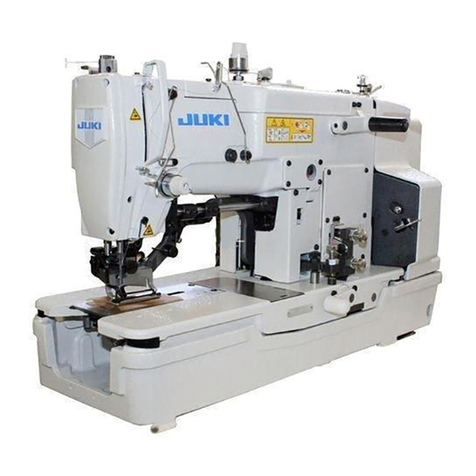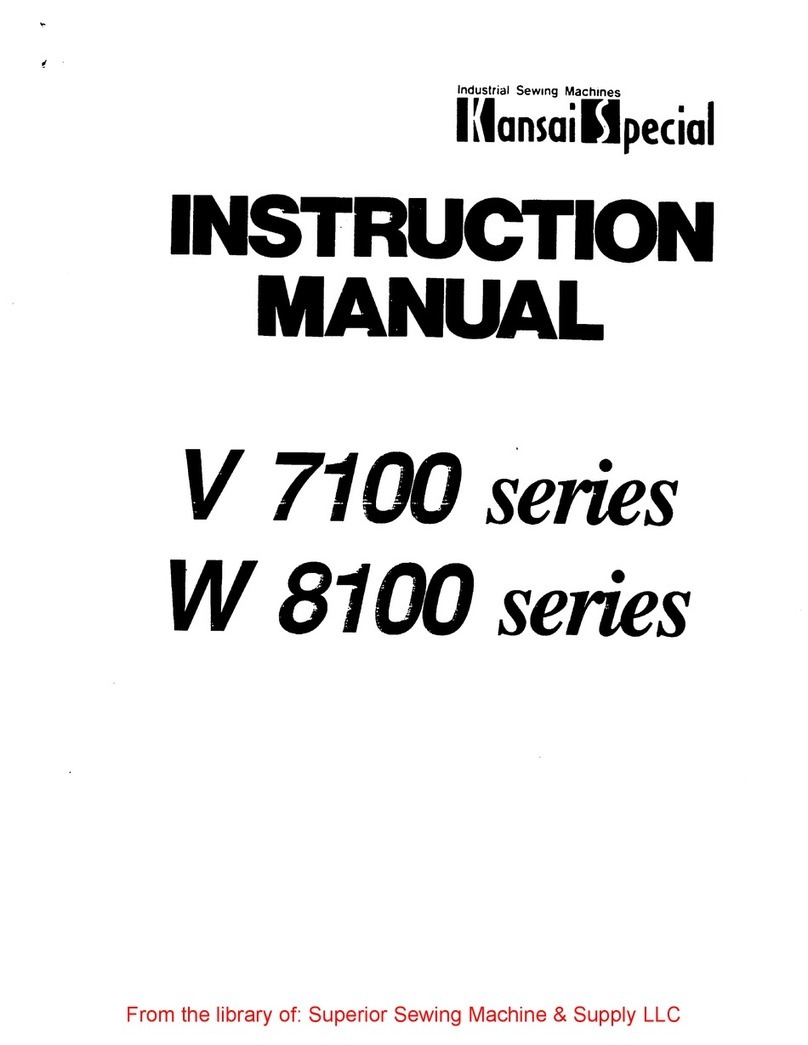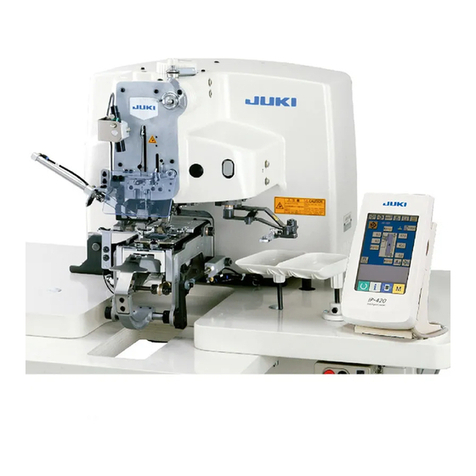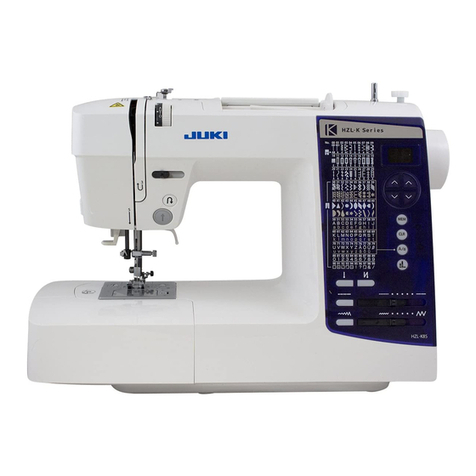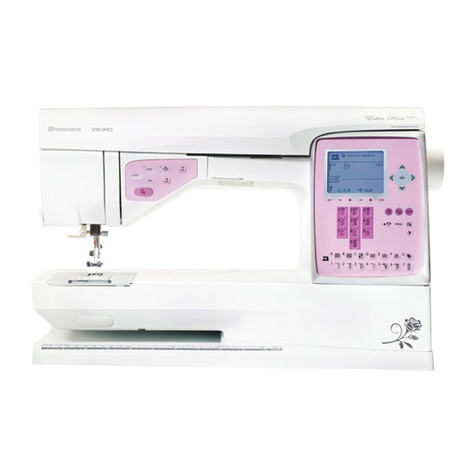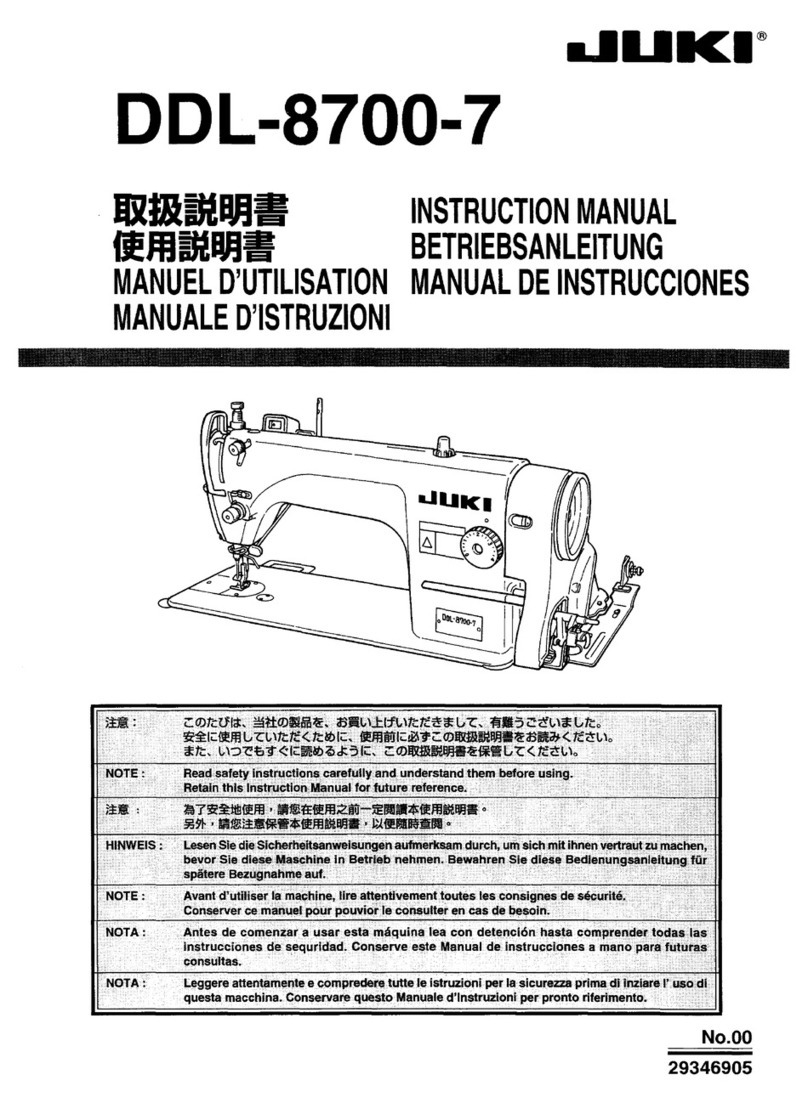John Lewis JL 300 User manual

1
ESSENTIAL PARTS .......................................................................... 2
Names of Parts ...............................................................................................2
Standard Accessories ..................................................................................... 3
For free arm sewing ........................................................................................4
To Store Foot Control ......................................................................................4
Extension Table ...............................................................................................4
GETTING READYTO SEW ............................................................... 4
Connecting the Machine to the Power Supply ................................................4
Controlling Sewing Speed ...............................................................................5
Up/Down Needle Position Button ....................................................................5
Sewing Light.................................................................................................... 5
Pressure Adjusting Lever ................................................................................6
To Snap On and Snap Off the Presser Foot ...................................................6
Dropping the Feed Dogs .................................................................................6
To Detach and Attach the Foot Holder ............................................................7
Persser Foot Lifter ...........................................................................................7
Reverse Stitch Button .....................................................................................7
Seam Guide Line ............................................................................................7
Changing Needles ...........................................................................................8
Thread and Needle Chart ...............................................................................8
Wind the thread on the bobbin ........................................................................9
Winding the Bobbin .........................................................................................9
Inserting the Bobbin ......................................................................................10
Threading the Machine .................................................................................11
To Use Needle Threader ...............................................................................11
Drawing UP Bobbin Thread ...........................................................................12
Balancing Needle Thread Tension ................................................................ 13
Auto-tension .............................................................................................13
Manual Needle Thread Tension ................................................................13
Pattern Selector Dial .....................................................................................14
Zigzag Width Control ..................................................................................... 14
Stitch Length Dial ..........................................................................................14
Variable Needle Position ...............................................................................14
BASIC SEWING ............................................................................... 15
Changing the Sewing Directions ....................................................................15
Straight Stitch Sewing ....................................................................................15
Sewing from the Edge ofThick Fabric............................................................15
UTILITY STITCHING ....................................................................... 16
Overedge Stitch .............................................................................................16
Zigzag Stitching .............................................................................................16
Tricot Stitch ....................................................................................................16
Overcasting ....................................................................................................16
Triple Strength Stitch ......................................................................................17
Outline Stretch Stitch .....................................................................................17
Sewing Buttons ..............................................................................................18
Automatic Buttonhole .....................................................................................19
To repeat buttonhole sewing ..........................................................................20
Manual Buttonhole .........................................................................................21
Corded Buttonholes .......................................................................................22
Zipper AppIication ..........................................................................................23
Rolled Hem ....................................................................................................25
Blind Stitch Hemming.....................................................................................26
DECORATIVE STITCHING .............................................................. 27
Decorative Satin Stitch Patterns ................................................................... 27
Stretch Stitch Patterns ...................................................................................27
Quilting ...........................................................................................................28
Smocking .......................................................................................................28
Pin Tucking .....................................................................................................29
Shell Tuck .......................................................................................................29
Applique .........................................................................................................30
Fagoting .........................................................................................................30
Adjusting Stretch Stitch Balance ....................................................................31
Patch Work .....................................................................................................31
CARE OFYOUR MACHINE............................................................. 32
Cleaning the Hook Race ................................................................................32
Cleaning the Bobbin Holder ...........................................................................32
Trouble Shooting ............................................................................................33
TABLE OF CONTENTS

2
Names of Parts
ESSENTIAL PARTS
e
w
q
y
o
!0
!7
t
r
!8
!6
@2
@3
#2
#4 #3
!1
!2
!3
!4
!5
@0
!9
@1
@6
@5
@4
#1
#0
@9
@8
@7
1 Pattern selector dial
2 Stitch length dial
3 Pattern indicating window
4 Zigzag width control
5 Spool holder
6 Spool pin
7 Auto thread tension LED
8 Thread tension dial
9 Bobbin winder thread guide
10 Thread guide
11 Thread take-up lever
12 Face plate
13 Thread cutter
14 Needle threader
15 Presser foot
16 Hook cover plate
17 Extension table
18 Hook cover plate release button
19 Up/down needle position button
20 Reverse stitch button
21 Speed setting lever
22 Balance wheel
23 Feed balance dial
24 Lamp switch
25 Power switch
26 Machine socket
27 Drop feed lever
28 Free arm
29 Buttonhole lever
30 Presser foot lifter
31 Extra spool pin mounting hole
32 Carrying handle
33 Bobbin winder spindle
34 Bobbin winder stopper
u
i

3
Standard Accessories
!1 !2
!3 17
qwrte y
uio
!0
!4
!5
!6
!7
The accessories can be stored in the ex-
tension table. Pull the lid to open the ac-
cessory storage.
qA. Zigzag foot (set on the machine)
wC. Overedge foot
eD. Hemmer foot
rE. Zipper foot
tB. Transparent buttonhole foot
yG. Blind stitch hem foot
uR. Automatic buttonhole foot
iLimt brush
oBobbins
!0 Set of needles
!1 Quilter
!2 Screwdriver
!3 Additional spool pin
!4 Seam ripper
!5 Spool pin felt
!6 Small spool holder
!7 Screwdriver (small)

4
Extension Table
The extension table provides added sewing surface and can be easily
removed for free arm sewing.
For free arm sewing
Remove the extension table by pulling it sideway.
e
w
q
To Store Foot Control
qInsert the foot control in the extension table.
wPlug the cord into the holes on the table.
eFold the cord as illustrated and store in the table.
GETTING READY TO SEW
q
e
w
Lamp switch
Connecting the Machine to the Power Supply
After turning ´´OFF ´´ the power switch, connect the plugs in the order of q,
wand e.
Then turn ´´ON ´´ the power switch and lamp switch.
* Disconnect the power supply plug and foot control plug when the machine
is not used.
Power switch

5
Up/Down Needle Position Button
Pres this button to bring the needle up or down.
If the needle is up, it will go down to the lowest position by pressing this button.
If the needle is down, it will go up to the highedt position by pressing this button.
Use this button when:
-
picking up the bobbin thread (see page 12).
-
lowering the needle into the fabric to turn a square corner (see page 15).
Low high
Controlling Sewing Speed
★★
★★
★Speed Setting Lever
The maximum sewing speed can be controlled
by the speed setting lever.
To increase the speed, slide the lever to the
right (toward ).
To decrease the speed, slide the lever to the
left (toward ).
★★
★★
★Foot Control
Sewing speed can be varied by the foot
control.
The harder you press on the control, the
faster the machine runs.
Sewing Light
The sewing light is located behind the face plate.
To replace the bulb
Caution: Turn off the power switch and disconnect the
power supplu plug before replacing the bulb.
The bulb could be HOT, wait until it has cooled down
before handling it.
Open the face plate. Pull the bulb out from the lamp
socket. Insert a new bulb into the socket, aligning the
pins with the holes in the socket.
Face plate Bulb Lamp socket

6
To raise the feed
dogs,push the lever to
the direction of arrow
as illustrated.
Open face plate
Pressure adjusting lever
3(Ordinary sewing)
Pressure Adjusting Lever
The pressure adjusting lever should be set at ´´3 ´´ for regular sewing.
Reduce the pressure to ´´2 ´´ for applique, cut work, drawn work, basting
and embroidery.
Set the pressure to ´´1´´ when sewing chiffon, lace, organdy and other
fine fabrics. Velours and knits with a lot of stretch may also require a
´´1´´ setting.
Dropping the Feed Dogs
Drop feed lever is located underneath of free arm bed.
For dropping the feed
dogs, push the lever
to the direction of
arrow as illustrated.
* Feed dogs must
always be up for normal
sewing.
To Snap On and Snap Off the Presser Foot
To snap off
Turn the balance wheel toward you to raise the
needle to its highest position.
Raise the presser foot.
Press the red button on the back of the foot holder.
The presser foot will drop off.
To snap on
When attaching the presser foot, the pressure
adjusting lever should always be at position ´´3 ´´.
Place the presser foot so the pin on the foot lies
just under the groove of the foot holder.
Lower the foot holder to lock the foot in place.

7
Persser Foot Lifter
The presser foot lifter raises and lowers the presser
foot. You can raise it 0.6 cm (1/4") higher than the
normal up position for easy insertion of the thick
fabric.
To Detach and Attach the Foot Holder
To Detach
Remove the thumb screw by turning
the screw counter- clockwise with
the screwdriver.
To Attach
Align the hole in the foot holder with the
threaded hole in the presser bar and fit the foot
holder screw into the hole. Tighten the screw by
turning it clockwise.
Reverse Stitch Button
As long as you keep the reverse stitch
button depressed, the machine sews
backwards.
The seam guides on the needle plate and hook cover
plate help you measure seam width.
The number indicates the distance between the center
needle position and the line.
Seam Guide Line

8
Changing Needles
Raise the needle by turning the
balance wheel toward you and lower
the presser foot.
Turn off the power switch.
Loosen the needle clamp screw by
turning it toward you.
Remove the needle from the clamp.
Insert the new needle into the needle
clamp with the flat side away from you.
When inserting the needle into the
clamp, push it up as far as it will go and
tighten the clamp screw firmly with the
screwdriver.
Thread and Needle Chart
Light
weight
Medium
weight
Fabrics Threads
Crepe de Chine, Voile
Lawn, Organdy, Georgette,
Tricot
Linens, Cotton, Pique,
Serge, Double Knits,
Percale
50 silk
50 to 80 Cotton
50 to 60
Synthetic
Cotton Covered
Polyester
Fine Silk
Fine Cotton
Fine Synthetic
Fine Cotton Covered
Polyester
9 (65)
or
11 (75)
11 (65)
or
14 (90)
Heavy
weight Denim, Tweed, Gabardine,
Coating, Drapery and
Upholstery Fabric
50 silk
40 to 50 Cotton
40 to 50 Synthetic
Cotton Covered
Polyester
14 (90)
or
16 (100)
Needle Size
* In general, fine threads and needles are used for sewing thin fabrics,
and thicker threads and needles are used for sewing heavy fabrics.
Always test thread and needle size on a small piece of fabric which will be
used for actual sewing.
* Use the same thread for needle and bobbin.
* When sewing stretch, very fine fabrics and synthetics, use a BLUE
TIPPED needle.
The blue tipped needle effectively prevents skipped stitches.
* When sewing very fine fabrics, sew over a piece of paper to prevent yarn
distortion.

9
Horizontal Spool Pin
Lift up the spool pin. Place the spool of thread on the
spool pin with the thread coming off the spool as
shown.
Attach the large spool holder pressing it firmly
against the thread spool.
* The small spool holder is used with narrow or
small thread spools.
Additional Spool Pin
The additional spool pin is used to wind extra
bobbins without unthreading the machine.
To use, insert the additional spool pin in the hole.
Place the felt and the spool on the pin.
Removing the Bobbin
Gently slide the hook cover plate release button to
the right, and remove the cover plate.
Lift out the bobbin.
Ordinary Spool
Small Spool
q
w
ert
ert
qPlace a spool on the spool pin.
The thread end should come off
as shown.
wGuide the thread around the
thread guide.
eThread through the
hole in the bobbin
from the inside to
the outside.
Put the bobbin on
the bobbin winder
spindle
rPush it to the right. With the free
end of the thread held in your
hand, depress the foot control.
Stop the machine when the bobbin
has made a few turns, and cut the
thread close to the hole in the
bobbin.
* Stop running the machine
without fail in advance when
moving the bobbin winder spindle.
tDepress the foot control
again. When the bobbin is
fully wound, it will stop
automatically.
Return the bobbin winder
to its original position by
moving the spindle to the
left, and cut the thread as
shown.
Winding the Bobbin
Wind the thread on the bobbin

10
Guide the thread into the notch Aon
the front side of the bobbin holder.
Draw the thread to the left sliding it
between the tension spring blades.
Inserting the Bobbin
Place the bobbin in the bobbin holder
with the thread running counter-
clockwise.
Continue to draw the thread lightly
until the thread slips into notch B.Pull out about 15 cm (6´´) of thread
and attach the hook cover plate.

11
qw
ert
w
r
t
e
q
To Use Needle Threader
qRaise the needle to its
highest position.
Lower the needle threader
Aas far as it will go.
wTurn the knob Ain the direction of the
arrow in the illustration, the hook B will
come out through the needle eye.
Lead the thread around the guide C
and under the hook B.
eTurn the knob Ain the
direction of the arrow in
the illustration, then
draw the thread loop to
the back of the needle.
rRaise the needle
threader knob Aslowly to
draw the thread loop up.
tPass the end of the
thread through the
needle eye by pulling
the thread loop to the
back.
Threading the Machine
Raise take-up lever to its highest
position by turning balance wheel
toward you.
Raise the presser foot with the
presser foot lifter and pass the
thread in the order from qto t.
qLead the thread from the
spool and pass it through
the thread guide. Then
draw it down along the
right slot.
wGuide the thread
around the bottom
of the thread guide
plate from right to
left, then draw it
upward.
eFirmly draw the
thread from the
right to the left over
the take-up lever
and down into the
take-up lever eye.
Then guide it down
along the left slot.
rSlide the
thread from
the left behind
the needle bar
thread guide.
tThread the
needle from
front to back.

12
Drawing UP Bobbin Thread
qRaise the presser foot and hold the needle
thread lightly with your left hand. ePull 15 cm (6´´) of both threads back and
under the presser foot.
wPress the Up/Down needle position button
twice to pick up the bobbin thread.
Draw up the needle thread forming a loop of
bobbin thread.

13
Balancing Needle Thread Tension
The bobbin thread appears on the
upper surface of the fabric. The needle thread appears on the
underside of the fabric.
For Straight Stitch:
The ideal straight stitch will have threads locked between the two layers of fabric.
For Zigzag Stitch:
In the correct zigzag stitch, the bobbin threads will not show on the top side of fabric
and the top thread will show slighly on the bottom side.
Auto-tension
This machine features an "AUTO" tension setting, which covers a
wide range of sewing condition.
Set the thread tension dial at "AUTO" for general sewing, unless
specifically indicated in this manual.
Manual Needle Thread Tension
Manual tension adjustment may be required depending on the sewing materials,
layers of fabric and other sewing condition.
Setting mark
* The needle thread is too tight. * The needle thread is too loose.
Loosen the needle thread tension
by moving the dial to a lower
number.
Tighten the needle thread tension
by moving the dial to higher
number.
Bobbin thread
Needle thread
The green signal will
light up when setting
the dial at "AUTO".

14
A
B
Pattern Selector Dial
Turn the pattern selector dial to select
the desired pattern.
Turn the dial toward A to select a
higher number pattern, or toward B to
select a lower number pattern.
The selected pattern will be shown in
the pattern indicating window.
Note: Do not turn the pattern selector
dial while the needle id in the fabric.
Zigzag Width Control
Higher the number, wider the stitch
width.
This machine will sew the maximum
6.5 mm (1/4´´) wide zigzag.
Note: Do not alter zigzag width while
the needle is in the fabric.
Stitch Length Dial Variable Needle Position
The higher the number, the longer the
stitch length. You can select the
suitable stitch length for fabrics that
you plan to sew.
Note: Stitch length is automatically
set for stretch stitch patterns when
pattern number 14 to 23 have been
selected.
When pattern number 13 is selected,
you can move the needle position
between the center and left with the
stitch width control.

15
Straight Stitch Sewing
Raise the presser foot and position
the fabric next to a stitching guide line
on the needle plate.
Lower the presser foot and smooth
the threads toward the back. Depress
the foot control.
Gently guide the fabric along the
guide line letting the fabric feed
naturally.
For fastening the ends of seams,
press the reverse stitch button and
sew several reverse stitches.
Raise the presser foot and remove the
fabric, drawing the threads to the
back.
The threads are cut the proper length
for starting the next seam.
Machine Setting
BASIC SEWING
Sewing from the Edge of Thick Fabric
The blacl button on the zigzag foot locks the foot to avoid slipping
when sewing from the extreme edge or sewing across the hem.
Lower the needle into the fabric at the point to start sewing. Lower the
foot while pushing in the black button. The foot is locked in the
horizontal position.
The foot will be unlocked automatically after sewing a few stitches.
Changing the Sewing Directions
Stop the machine and bring the needle down int the fabrics by
pressing Up/Down needle position button.
Raise the presser foot.
Pivot the fabric around the needle to change sewing direction
as desired.
Lower the presser foot.

16
Machine Setting Machine Setting
Zigzag Stitching
Simple zigzag stitching is widely used
for overcasting, appliqueing, sewing
on buttons etc.
Overcasting
Finish a raw edge of the fabric with
the zigzag stitch to prevent fraying.
Place the raw edge next to the black
guide on the foot and start sewing.
Note: Do not set the stitch width less
than 5 when using the foot C.
UTILITY STITCHING
Machine SettingMachine Setting
Overedge Stitch
This stitch overcsts and seams a raw
edges at the same time, it preventing
frauing.
Place the raw edge next to the black
guide on the foot and start sewing.
Note: Do not set the stitch width less
than 5 when using the foot C.
Tricot Stitch
Place the fabric under the presser foot
so that the edge will be slightly inside
the right hand side of the presser foot.
Guide the work so the right hand
stitches fall at the edge of the fabric.

17
Triple Strength Stitch
This strong, durable stitch is recom-
mended where both elasticity and
strength are needed to insure comfort
and durability.
Use it to reinforce areas such as crotch
and armhole seams.
Also use when constructing items such
as backpacks for extra strength.
The stitch is sewn with two stitches
forward and one stitch backward
forming a seam that does not rip easily.
Garments should be basted for fitting
before seaming.
Machine Setting
Machine Setting Outline Stretch Stitch
Pattern 14 is a narrow stretch stitch
designed to eliminate puckering on
knit fabrics and bias seams, while
permitting the seam to be pressed
completely flat.
For a 1.5 cm (5/8´´) seams, use the 2
cm (6/8´´) marking on the needle plate .
When sewing light weight fabrics, set
the pressure adjusting lever at ´´1´´ or
´´2´´.

18
Machine Setting
Sewing Buttons
Drop the feed dog and unthread the needle. Adjust the stitch width to match the
needle swing with the span o f the
holes in the button.
Re-thread the needle and lower
the presser foot to hold the button
in place.
Turn the handwheel toward you to
check the needle enters both
holes in the button.
A pin can be placed on the foot to
form a shank.
Depress the foot control to sew 10
stiches and stop the machine.
Raise the foot and remove the
fabric, and cut the threads leaving
20 cm (8") tail.
Draw the needle thread
through the hole in the button
to bring it between the button
and fabric.
Pull the needle thread to pick
the bobbin thread up to the
right side of the fabric.
Wind the treads in opposite
direction around the thread
shank and tie them together.
Note: After finishing sewing,
raise the feed dog.

19
Note: There should be no gap
between and .
Machine Setting Automatic Buttonhole
* The size of buttonhole is
automatically set by placing the
button in the automatic buttonhole
foot (R).
* The button holder of the foot takes
a button size up to 2.5 cm (1´´) in
diameter.
* Make a test buttonhole on a sample
duplicating the fabric, interfacing
and seams of the actual garment.
* Place the button on the fabric
sample and mark the top and
bottom to determine the position of
buttonhole.
* Use the interfacing on the stretch
fabrics.
q
e
qRaise the needle and the presser bar.
Place the autmatic buttonhole foot with
the pin just under the groove of the
foot holder. Lower the presser bar to
attach the buttonhole foot.
Select the pattern BH by turning the
pattern selector dial.
Buttonhole lever Touch
r
eDraw the needle thread to the left through the
hole in the foot. Place the fabric under the foot
and lower the needle at the starting point of the
buttonhole mark. Then lower the foot
Starting point
wPull the button holder to the back, and place the
button in it. Push back the button holder toward
you as far as it will go.
Pull the buttonhole lever downward as far as it
will go.
rDeoress the foot control to sew a buttonhole.
Stop the machine when the buttonhole is com
pleted.
Starting point
w

20
After buttonhole sewing is finished, push
the buttonhole lever up as far as it will
go.
To repeat buttonhole sewing.
Select pattern number 1 ( ) by turning the pattern selector dial
toward 1. Then re-select the buttonhole by turning the dial toward 2to
reset for sewing the next buttonhole.
Raise the foot and remove the fabric.
Cut the threads leaving a 10 cm (4") tails. Pull the
bobbin thread to bring the needle thread to the
wrong side of the fabric, and tie them together.
Place a pin just before the bartack to prevent
cutting the bartack.
Cut opening with the seam ripper.
Table of contents
Other John Lewis Sewing Machine manuals
